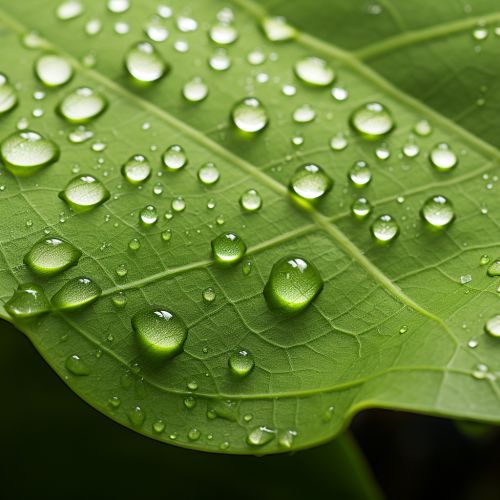Lotus Effect
Introduction
The Lotus effect refers to the self-cleaning properties exhibited by the leaves of the lotus flower (Nelumbo nucifera). This phenomenon, observed in several other plants, is attributed to the nano- and microscale structure of the leaf surface, which repels water and causes it to bead up and roll off, carrying away dirt and debris. The term "lotus effect" was coined by botanists Wilhelm Barthlott and Christoph Neinhuis in 1997, and it has since inspired numerous applications in materials science and engineering.
Biological Basis
The lotus effect is a result of the complex structure of the lotus leaf surface. The leaf is covered in microscopic papillae, or bumps, each about 10 to 20 micrometers in height and covered in a layer of hydrophobic (water-repelling) wax. These papillae are spaced about 10 to 20 micrometers apart, creating a rough surface that repels water and causes it to bead up into droplets. This is an example of a superhydrophobic surface, defined as a surface that has a contact angle with water of greater than 150 degrees.


When a water droplet lands on a lotus leaf, it is not able to spread out and wet the surface due to the hydrophobic wax and the roughness of the surface. Instead, it forms a nearly spherical droplet, which can easily roll off the leaf. As it rolls, it picks up particles of dirt and debris from the leaf surface, effectively cleaning the leaf. This is known as the self-cleaning property of the lotus effect.
Applications
The lotus effect has inspired a wide range of applications in materials science and engineering, particularly in the development of self-cleaning surfaces. These include self-cleaning windows, solar panels, and building facades, as well as water-repellent clothing and anti-fouling coatings for ship hulls. The principle has also been applied in the design of medical devices to prevent the adhesion of bacteria and other microorganisms.
One of the most well-known applications of the lotus effect is in the paint industry. Lotusan, a brand of self-cleaning exterior paint, mimics the microstructure of the lotus leaf to create a superhydrophobic surface that repels water and dirt. This results in a long-lasting, low-maintenance finish that remains clean and bright even in harsh weather conditions.
Challenges and Limitations
While the lotus effect has been successfully applied in many areas, there are still challenges and limitations to its use. One of the main challenges is the durability of superhydrophobic surfaces. In many applications, these surfaces are exposed to mechanical wear and tear, which can damage the micro- and nanoscale structures that give rise to the lotus effect. Researchers are currently exploring ways to make superhydrophobic surfaces more robust and durable.
Another limitation is that the lotus effect is not effective against oil and other non-polar substances. This is because the hydrophobic wax on the lotus leaf is non-polar, and like dissolves like. Therefore, oil and other non-polar substances can spread out and wet the leaf surface, rather than beading up and rolling off. This limits the effectiveness of lotus-inspired self-cleaning surfaces in environments where oil or other non-polar substances are present.
